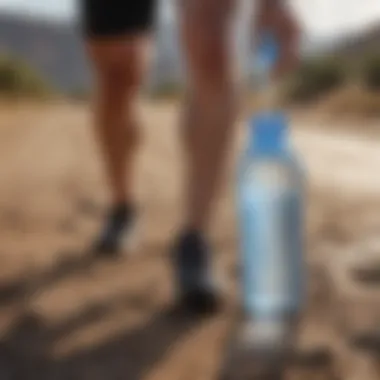Effective Methods for Relieving Sore Calf Muscles


Intro
Sore calf muscles are a common complaint among those engaged in physical workouts. Understanding how to relieve this discomfort is crucial for effective recovery. After exercising, it is normal for muscles to experience some level of soreness. However, not addressing this soreness can lead to longer recovery times and hinder overall performance.
The calf muscles play a significant role in various physical activities, including running, cycling, and various forms of bodyweight exercises. Recognizing the discomfort in this area and knowing how to alleviate it is essential for maintaining a consistent fitness routine.
In this article, we will discuss practical methods designed to relieve sore calf muscles after workouts. These methods cover immediate post-exercise care and long-term strategies for prevention.
Key Benefits
Physical Health Benefits
Addressing sore calf muscles through proper recovery techniques aids in muscle repair and enhances performance in subsequent workouts.
- Reduced Recovery Time:
By applying effective recovery methods, muscular soreness can decrease significantly, allowing one to resume physical activity sooner. - Injury Prevention:
Consistent care of sore muscles minimizes the risk of developing more severe injuries, such as strains or tears, which can hinder progress. - Improved Flexibility and Mobility:
Proper stretching and recovery practices promote better flexibility in the calf muscles. This is crucial for maintaining a full range of motion.
Mental Well-being Enhancements
Not only does muscle recovery impact physical health, but it has psychological benefits as well.
- Stress Reduction:
Engaging in recovery activities, such as stretching or heat therapy, can promote relaxation and reduce stress following a workout. - Increased Motivation:
When muscle soreness is effectively managed, individuals are more likely to stay committed to their fitness routines, fostering a positive mindset.
"Caring for sore muscles not only improves physical health but also contributes to enhanced mental clarity and focus."
Practical Tips
Effective Meal Planning
Nutrition plays a vital role in muscle recovery. Here are key points for meal planning:
- Incorporate Protein-Rich Foods:
Consuming foods such as chicken, fish, eggs, and legumes helps in muscle repair. - Stay Hydrated:
Adequate hydration optimizes recovery and supports muscle function. Aim for water, sports drinks, or electrolyte solutions post-workout. - Include Antioxidant-Rich Foods:
Fruits like berries and vegetables such as spinach can help reduce inflammation.
Quick and Efficient Workouts
Incorporating dynamic stretches and proper warm-ups can prevent soreness from occurring in the first place.
- Dynamic Stretching Before Workouts:
Activities like leg swings or ankle circles prepare the calf muscles for exercise, reducing the risk of soreness. - Cool Down Routine:
Post-workout stretches specifically targeting the calves can aid in preventing stiffness and soreness.
In summary, understanding and applying methods to relieve sore calf muscles post-workout can significantly enhance recovery. These practices not only support muscle health but also contribute to overall well-being.
Understanding Calf Muscle Soreness
Calf muscle soreness is a common experience for individuals engaged in physical activity. This phenomenon, often referred to as delayed onset muscle soreness (DOMS), can arise after intense workouts or unfamiliar physical tasks. Understanding this soreness is crucial for effective recovery and continued performance in athletic endeavors. Knowledge of calf muscle structure and function can inform both training regimens and recovery techniques, ensuring that athletes and fitness enthusiasts maintain a balanced approach to their training.
The Anatomy of the Calf Muscles
The calf muscles primarily consist of the gastrocnemius and soleus muscles. The gastrocnemius has two heads and is the larger of the two, creating the calf’s prominent bulge. It plays a key role in activities that involve running, jumping, and climbing stairs. The soleus lies beneath the gastrocnemius and is crucial for maintaining posture and providing stability during standing and walking.
Both muscles connect to the Achilles tendon, which secures their attachment to the heel bone. This anatomy highlights the importance of these muscles in overall mobility and athletic performance. Therefore, an understanding of how these muscles function can aid in recognizing the sources of soreness and implementing corrective measures.


Causes of Calf Muscle Soreness
Several factors can contribute to soreness in the calf muscles. Common causes include:
- Intensity of Exercise: Increased intensity or duration can lead to microscopic tears in muscle fibers, resulting in pain and stiffness.
- New Activities: Engaging in unfamiliar activities often taxes muscles differently, leading to soreness.
- Poor Warm-Up: Inadequate warm-up routines can starve muscles of proper blood flow, making them more susceptible to injury.
- Dehydration: Insufficient hydration can impair muscle function and exacerbate cramps and soreness.
- Improper Footwear: Wearing shoes that do not provide adequate support can contribute to calf discomfort.
Understanding these causes helps in tailoring training and recovery strategies more effectively.
Distinguishing Between DOMS and Injury
While calf muscle soreness is often harmless and a sign of muscle adaptation, it is essential to differentiate between normal DOMS and potential injury.
Key Differences:
- Timing of Onset: DOMS typically appears 24 to 48 hours post-exercise. Immediate pain may indicate a strain or tear.
- Type of Pain: DOMS usually manifests as a dull ache or stiffness, whereas an injury might surface as acute, sharp pain.
- Range of Motion: With DOMS, the range of motion might be limited due to discomfort but is often manageable. In contrast, an injury can result in significant limitations.
It is crucial to listen to your body and seek medical attention if pain persists.
Recognizing these subtle differences can aid individuals in making informed decisions about their recovery process and when to seek professional help.
Immediate Post-Workout Relief Strategies
The period immediately following a workout is critical for calf muscle recovery. This phase is when the body begins to repair the micro-tears created in muscle fibers during exercise. Implementing specific relief strategies during this time can significantly enhance recovery and ultimately improve performance. Engaging in immediate post-workout relief can help to reduce muscle soreness, restore flexibility, and promote better circulation, which feeds the muscles with necessary nutrients for repair.
Importance of Cool Down Exercises
Cool down exercises play a pivotal role in the recovery process after intense physical activity. These movements are designed to gradually reduce heart rate and alleviate tension in the muscles. When you cool down effectively, you facilitate a smoother transition from vigorous activity to rest. Moreover, cool downs help maintain flexibility and reduce the risk of injury. They can also prevent blood from pooling in the lower extremities, which can cause dizziness or faintness. Simple activities like slow walking or light cycling for 5-10 minutes can serve as an excellent cool down.
Gentle Stretching Techniques
Gentle stretching after a workout is essential for relieving tightness in the calf muscles. Stretching helps in elongating the muscles and restoring their length, which can be compromised during an intense routine. Specific stretches like the calf stretch and the soleus stretch can be particularly effective. Holding each stretch for 15-30 seconds consistently can aid in improving flexibility and decreasing muscle soreness. This practice also encourages blood circulation, which is vital for nutrient delivery and waste removal in the muscle tissue.
Foam Rolling for Muscle Recovery
Foam rolling serves as an effective self-myofascial release technique to alleviate muscle tightness and enhance recovery. Utilizing a foam roller on the calf muscles can help break up adhesions and increase blood flow to the area. This technique is especially useful for targeting specific muscle knots that may not be addressed through conventional stretching. During foam rolling, it is ideal to spend about one minute rolling each calf muscle, pausing on tender spots to allow for deeper relief. This practice can lead to reduced pain and increased muscle function over time.
Cold Therapy Applications
Cold therapy is another crucial strategy to relieve sore calf muscles following a workout. Applying ice or using cold packs can help minimize inflammation and numb sharp pain. Using cold therapy within the first 24 hours post-exercise can be beneficial, especially if you experience significant soreness. A common approach is to apply ice to the targeted area for 15-20 minutes, several times a day. Be mindful of wrapping the ice in a cloth to prevent skin damage. Cold baths or ice baths can further expedite muscle recovery, particularly after strenuous workouts.
"Cold therapy not only alleviates pain but also helps in reducing swelling, paving the way for faster recovery."
In summary, immediately addressing muscle soreness after a workout through these strategies can significantly improve recovery outcomes. Each method complements the next, creating a comprehensive approach to muscle care that is essential for athletes and fitness enthusiasts alike.


Long-Term Recovery Techniques
Long-term recovery techniques are essential for ensuring that calf muscles heal properly after strenuous workouts. These strategies not only help in relieving soreness but also enhance overall muscle health and performance. Implementing a consistent recovery routine minimizes the risk of future injuries and enables quicker adaptation to training regimes. The benefits of focusing on long-term recovery include improved muscle function, better performance in subsequent workouts, and an overall increase in physical wellness.
Incorporating Rest Days
Rest days play a crucial role in muscle recovery. When calf muscles undergo strain during exercise, they need time to repair. Overworking these muscles can lead to chronic soreness or even injuries. By incorporating rest days into a workout routine, a person allows adequate time for muscle fibers to heal and adapt. This rest is not merely about avoiding workouts; it can involve light activities such as walking or gentle stretching. The key is to give muscles a break, preventing overuse and reducing the risk of injuries.
Hydration and Its Role in Recovery
Hydration significantly influences recovery processes. Water helps maintain muscle function by transporting nutrients and removing waste products from muscle activity. Proper hydration also aids in regulating body temperature and lubricating joints. Fatigue and cramping are common signs of dehydration, which can exacerbate soreness following workouts. As such, ensuring sufficient fluid intake before, during, and after exercise is vital. Including electrolyte-rich drinks can be beneficial, particularly after intense workouts, to replenish the necessary minerals lost through sweat.
Nutrition for Muscle Repair
Proper nutrition is vital for effective recovery following muscle exertion. It helps facilitate the repair process and prepares the body for future activities. A balanced diet rich in proteins, vitamins, and minerals can support muscle healing and adaptation. Nutritional strategies can greatly influence recovery success, making it essential to prioritize food intake.
Protein Sources
Protein is a key nutrient essential for muscle repair. It provides the building blocks—amino acids—that muscles need to recover after exercise. High-quality protein sources include lean meats, fish, eggs, dairy, and plant-based options such as lentils and beans. These sources are beneficial choices because they contain all necessary amino acids, supporting effective recovery. One unique feature of these proteins is their bioavailability, meaning they are absorbed effectively in the body, enhancing the repair process.
Essential Vitamins and Minerals
Essential vitamins and minerals also play crucial roles in muscle recovery. Vitamins like C and E have antioxidant properties that help combat oxidative stress caused by intense workouts. Minerals such as magnesium and potassium are vital for muscle function and preventing cramps. They support various biochemical processes that are necessary for recovery. Notably, a diet rich in fruits and vegetables can provide these nutrients, promoting overall health and enhancing recovery. Ensuring intake of these components is not just advantageous but necessary for optimal muscle repair.
Injury Prevention Practices
Injury prevention practices play a pivotal role in maintaining calf muscle health, especially for those who engage in regular physical activity. Implementing these practices does not only minimize the likelihood of injury, but also enhances overall performance and optimizes recovery. A preventive approach focuses on several key areas, including warming up properly, strengthening the muscles, and being attuned to one’s body. Each of these elements works synergistically to provide a robust defense against overuse and strain injuries.
Proper Warm-Up Techniques
A well-structured warm-up session is fundamental for preparing the body for an upcoming workout. Engaging in dynamic stretching and low-intensity activities helps to increase blood flow to the muscles. Such exercises might include light jogging, ankle circles, and toe-touches. The aim is to elevate the heart rate and loosen up the muscles, particularly the calves. A good warm-up can help make workouts more effective and lead to improved muscle coordination.
Why Warm-Ups Matter:
- Increases muscle temperature, which enhances flexibility and reduces stiffness.
- Activates the nervous system, improving responsiveness during the workout.
- Lowers the risk of tears and strains by preparing the muscles for intense exertion.
Strength Training for Calf Muscles
Strength training is crucial in developing resilient calf muscles. By engaging in targeted exercises, individuals can increase the muscle mass and strength, leading to better support during physical activities. Calf raises, for example, are an efficient way to directly strengthen these muscles.
Additionally, incorporating resistance training using bands or weights can further enhance muscle endurance and power.
Exercises to Consider:


- Standing calf raises: Perform on a flat surface or on the edge of a step for an increased range of motion.
- Seated calf raises: Can be done using a weight plate or dumbbells for added resistance.
- Single-leg raises: This adds an element of balance training, which is also valuable for overall stability.
Listening to Your Body
Being attuned to one's body is essential in injury prevention. It involves recognizing signs of fatigue, discomfort, or pain during and after workouts. Ignoring these cues may result in injuries that could sideline an individual for an extended period. Practicing mindfulness can significantly enhance awareness of physical sensations, allowing for timely rest and recovery.
Key Signals to Monitor:
- Persistent soreness that does not subside after rest
- Swelling or unusual bruising in the calf area
- A feeling of instability when walking or exercising
An ongoing dialogue about physical state can make a difference. Prioritizing recovery strategies when needed can favor long-term performance and health.
When to Seek Professional Help
Understanding when to seek professional help is crucial for anyone experiencing calf muscle soreness after a workout. Most muscle soreness can be managed with appropriate self-care techniques. However, certain situations demand the attention of a healthcare professional. Recognizing the symptoms that indicate a serious injury can prevent further complications and promote effective recovery.
Recognizing Symptoms of Serious Injury
It is essential to differentiate between normal post-exercise soreness and indications of a more severe issue. Symptoms suggesting a serious injury may include:
- Severe pain that escalates rather than diminishes over time.
- Swelling that is disproportionate to the level of activity or persists for an extended period.
- Limited range of motion, making it difficult to walk or bear weight on the affected leg.
- Bruising that appears rapidly or covers a large area.
- Numbness or tingling in the lower leg or foot, suggesting possible nerve involvement.
- Persistent discomfort that does not improve with basic recovery measures such as rest, ice, or over-the-counter pain relief.
Recognizing these symptoms early can make a significant difference in recovery outcomes. If these signs appear, it is wise to consult a medical professional promptly.
Consulting a Physical Therapist
If you find yourself in a situation where you have recognized symptoms of a serious injury, consulting a physical therapist is a beneficial step. A qualified physical therapist can assess your condition more thoroughly than general self-care methods allow.
During the initial assessment, the therapist will evaluate the injured area and establish whether there is a need for further imaging studies or tests. They can create a tailored rehabilitation program that focuses on your specific needs, which may include:
- Targeted exercises to improve strength and flexibility.
- Manual therapy to reduce pain and ensure proper alignment of muscles.
- Education on injury prevention tailored to your activity level and exercise routine.
Working with a physical therapist can help facilitate a faster, safer recovery and prevent the recurrence of injuries. They provide support and strategies to adapt your workout plans to fit your recovery journey.
"Seeking professional help when in doubt is always a good practice. A healthcare provider can offer clarity and guidance that is necessary for your long-term well-being."
In summary, don’t hesitate to reach out to a professional if your symptoms raise concerns. Early intervention can pave the way for a more effective recovery process.
The End
Summary of Key Takeaways
This section consolidates several important points:
- Immediate Post-Workout Care: It is essential to engage in cool down exercises and gentle stretching right after workouts. These practices can help mitigate immediate muscle soreness and enhance recovery.
- Hydration and Nutrition: Maintaining adequate hydration is vital for muscle function. Proper nutrition, particularly adequate protein intake and essential vitamins, supports recovery and muscle repair.
- Injury Prevention: Understanding your body’s signals and practicing proper warm-ups can prevent injuries. Incorporating strength training into your routine can bolster calf muscle resilience.
- When to Seek Professional Help: Knowing when soreness indicates a potential injury is crucial. Consulting a physical therapist can provide specialized care tailored to recovery needs.
Final Thoughts on Recovery Practices
The journey to recovery is not just about healing; it is about understanding the body and respecting its limits.















